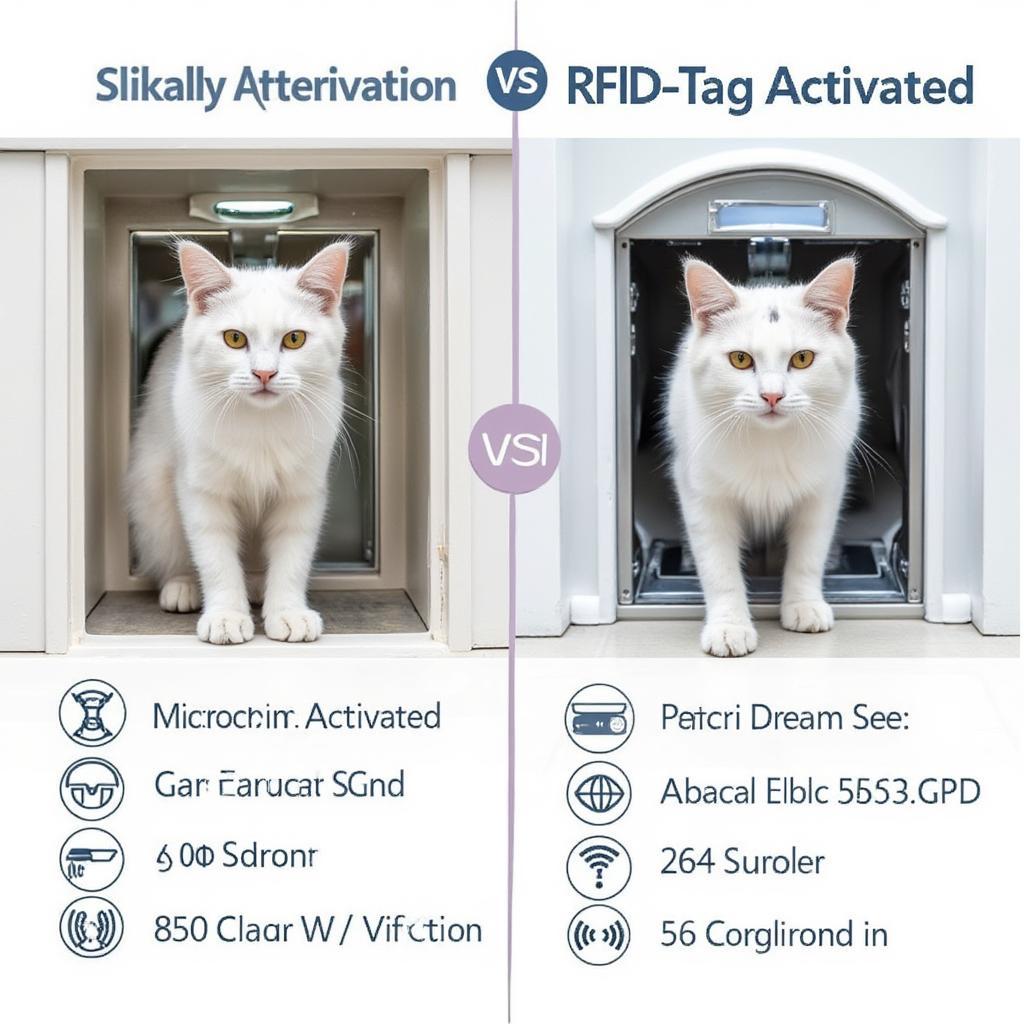Finding the Purrfect Fit: A Comprehensive Guide to Pet Smart Cat Doors

Choosing the right cat door can dramatically improve your feline friend’s quality of life, offering them freedom to explore and return at will, while also providing you peace of mind. A Pet Smart Cat Door isn’t just a simple flap; it’s an investment in your cat’s happiness and your home’s security. This guide will help you navigate the options, understand the benefits, and select the ideal door for your furry companion.
Understanding the Need for a Smart Cat Door
Why consider a smart cat door instead of a standard one? The answer lies in the added security, convenience, and control. Traditional cat doors offer no way to prevent unwanted critters from entering, nor do they provide any control over which cat goes in or out if you have multiple pets. Smart cat doors, however, utilize advanced technology like microchip identification to grant access only to your registered feline. This is particularly useful if you have cats with differing needs or if you want to keep neighborhood cats out. The days of waking up to a surprise visit from a racoon are officially over.
Types of Pet Smart Cat Doors
Before diving into specifics, let’s discuss the different types of smart cat doors available:
- Microchip Cat Doors: These doors read your cat’s existing microchip, allowing entry only to the programmed cat. This eliminates the need for your cat to wear a collar or tag.
- RFID Cat Doors: These doors use radio frequency identification (RFID) tags attached to your cat’s collar. While a collar is needed, this method is often less expensive than microchip options.
- Magnetic Cat Doors: These doors are triggered by a magnet attached to your cat’s collar. They are also a less expensive alternative, but can be less reliable as magnets can sometimes get lost or fall off.
- Bluetooth/WiFi Enabled Doors: These doors often have a companion app that allows you to set curfew times, track your cat’s comings and goings, and even remotely lock the door.
Key Features to Consider
Choosing the best smart cat door for your needs requires a thoughtful examination of several key features:
- Security: A main benefit is that a smart cat door will keep unwanted guests out. It should only grant entry to your cats and it is important to check the manufacturer’s security level and reviews before purchase.
- Installation: Depending on your setup and the type of cat door you select, some smart cat doors can require a bit of work to install, while some can be easily done yourself.
- Power: Smart cat doors may run on batteries or require an electrical connection, which is something to consider when purchasing.
- Size and Fit: Ensure the door opening is large enough for your cat to comfortably pass through. A proper fit prevents struggling and helps make it more appealing for your kitty to use.
- Materials: Weather resistance and durability is crucial, especially if the door is exposed to the elements. You’ll want to select a door made of high-quality materials that will last.
- Programmability: Some doors allow for specific programming features like curfews or dual-scan entry (requiring a microchip scan both in and out). If you have unique requirements, this could be a valuable feature.
- Warranty: A solid warranty can provide peace of mind in case any issues arise. Always read the fine print to understand coverage details.
“I’ve seen so many cat owners struggle with keeping unwanted wildlife out of their homes. A pet smart cat door is an investment in not only your pet but also your sanity,” says Dr. Emily Carter, DVM, a renowned feline behaviorist.
How to Choose the Right Pet Smart Cat Door for Your Cat
When selecting a smart cat door, consider your cat’s personality, size, and physical capabilities, as well as your own lifestyle needs. Do you have an elderly cat that might be hesitant to use a new door? Do you need a system to ensure your cat doesn’t leave during certain hours of the day? Below are some steps to consider:
-
Assess Your Cat’s Needs:
- Size: Measure your cat’s height and width to ensure they can comfortably pass through the door.
- Age and Mobility: If your cat is older or has mobility issues, look for doors with low thresholds.
- Personality: Some cats are braver than others. Choose a door that suits your cat’s personality, like one with a smooth, silent flap mechanism if your cat is easily startled.
-
Consider Your Home:
- Type of Door: Consider if your door will be installed in a wall, door, or window and make sure that the smart cat door you select is made for that application.
- Placement: Make sure to install your smart cat door in a place that is easy for your cat to access but also secure.
- Security Needs: Are there certain concerns that you have about entry into your home? If so, select a model with all of the security features you require.
- Climate: Is your area subject to extreme weather? Select a durable model that will withstand the elements.
-
Evaluate Different Models:
- Microchip vs. RFID: Weigh the pros and cons of microchip versus RFID technology based on cost and convenience.
- Battery Life vs. Electric: Consider whether you prefer battery-operated or hardwired models for ease of use.
- App Integration: For technologically savvy cat owners, a Bluetooth/WiFi enabled door might be a good choice.
- Reviews: Reading customer reviews is an excellent way to learn about the real-world performance of various models.
- Budget: As with all things, budget is a consideration. There is a wide variety of quality smart cat doors to match any budget.
Training Your Cat to Use a Smart Cat Door
Even the most sophisticated smart cat door won’t work if your cat refuses to use it. Here are a few tips to ease the transition:
- Initial Training: Start by propping the door open, allowing your cat to pass through without any resistance.
- Positive Reinforcement: Use treats and praise to encourage your cat to explore the new passage.
- Gradual Closure: Once your cat is comfortable, gradually lower the flap, using treats to encourage them through.
- Patience: It might take time, so stay patient and consistent.
Maintaining Your Smart Cat Door
Like any electronic device, your smart cat door will require some maintenance. Here’s what you need to do:
- Regular Cleaning: Keep the flap clean and free of debris to ensure smooth operation.
- Battery Replacement: If you have a battery-operated model, replace them according to the manufacturer’s instructions.
- Microchip or RFID Tag: Make sure the microchip is registered or that the collar and RFID tag are in good condition.
- Software Updates: If you have a WiFi-enabled door, ensure that the software is up to date.
“Owners sometimes forget the importance of consistency when training a cat. With patience, any cat can adapt to a smart cat door,” adds Dr. Carter. This applies to all felines, especially after looking at the number of times our team at Shock Naue has had to help with questions like 7 years in cat years or when a pet parent was trying to find a way to keep their cat safe and get some additional security from their cat door.
Addressing Common Issues with Pet Smart Cat Doors
Even the best-laid plans can run into unexpected issues. Here are some common problems you might encounter and how to address them:
- Cat Refusal: If your cat is hesitant, make sure that the door is set to allow for easy access and try using treats to encourage them.
- False Triggers: Sometimes, other electronic devices can trigger the door, especially with RFID options. In this case, look for options with secure, microchip options.
- Microchip Issues: If the door isn’t reading your cat’s microchip, double check that it is registered with the door’s device and that the cat is within the required reading distance of the door.
- Weather Damage: Make sure that the cat door is weather resistant and sealed appropriately to prevent water and wind damage.
The right pet smart cat door can help to make life easier for both you and your feline. While there might be some upfront investment and learning, in the end the safety and security they bring makes them a valuable addition to any cat lover’s home. Remember to consider all aspects such as size, technology, security and installation requirements to choose the ideal option for your unique needs.
When you are ready to upgrade your cat’s lifestyle, remember to consider the benefits that a pet smart cat door has to offer. “A quality pet smart cat door is more than just a convenience; it’s an investment in your cat’s health and happiness,” comments, Dr. Carter, who frequently suggests the added safety that these door provide to her clients.
Consider starting with a look into advantage multi for cats petsmart to get other essential equipment before you make an investment into a brand new smart cat door.

Conclusion
Ultimately, a pet smart cat door offers numerous benefits, from increased security to greater freedom for your cat. By carefully considering the available options, evaluating your specific needs, and implementing a thoughtful training plan, you can select and install a door that enhances the lives of both you and your feline companion. This decision is also important for new pet owners who are also looking for dogs for adoption good with cats near me and need a plan to manage multiple pets. Remember, a happy cat makes for a happy home.
Frequently Asked Questions (FAQ)
- What is a pet smart cat door?
A smart cat door is an electronic pet door designed to allow access only to authorized pets, usually through microchip, RFID tag, or magnetic recognition, providing enhanced security and control. - How does a microchip cat door work?
Microchip cat doors scan your cat’s existing microchip to grant access. The door will only open if it recognizes a pre-programmed microchip, keeping unwanted animals out and your cat safe. - Are smart cat doors secure?
Yes, smart cat doors are generally considered secure as they are designed to keep out unwanted animals and are far more secure than traditional cat doors. The technology will prevent other animals from entering. - How do I install a smart cat door?
Installation instructions vary by model, but generally, you will need basic tools like a drill, screwdriver, and possibly a saw. You might need to make a hole in your door or wall, so some customers choose to contact a handyman. - Can any microchip work with a smart cat door?
Most standard ISO microchips can be used, but confirm the specifics with the manufacturer before purchasing to ensure compatibility, especially if you have a specific type of chip in your cat. - What if my cat doesn’t have a microchip?
If your cat does not have a microchip, consider an RFID option, or a magnetic system. Another alternative is to take your cat to the vet to be implanted with a microchip for use with your new door. - What if my cat refuses to use the door?
Begin by propping the door open, and gradually close it once your cat becomes accustomed to passing through the opening. Use treats and encouragement to coax your cat through the door, rewarding them each time they successfully use the opening. - Do smart cat doors require batteries or electricity?
Some models run on batteries, while others need to be hardwired to an electrical source, this will depend upon the type you choose to purchase. Some battery options even include rechargeable capabilities. - Can smart cat doors be used in windows?
Yes, many models are designed for window installation, but you will need to confirm that the door is made for window installation. Make sure to measure properly before ordering a cat door for installation in a window.
Don’t forget to check out our other articles, like this one about raining cats and dogs rescue for more interesting information about our furry friends.




